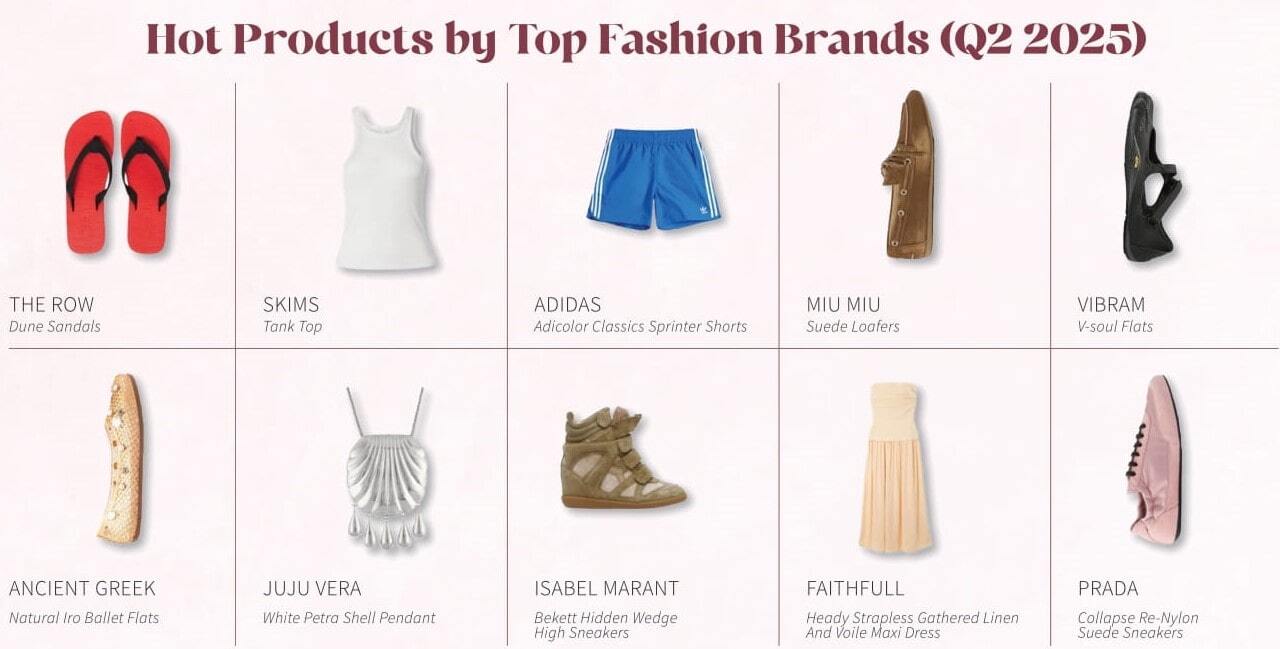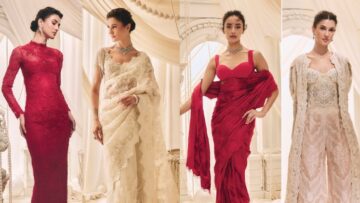Brands heat today is not about rankings alone but also about how brands and designers are blending heritage, culture and innovation to gather desirability.
This quarter, heritage remains a powerful anchor – as seen with Loewe’s Puzzle revival and Ralph Lauren’s Milan showcase, but Gucci’s slight decline shows the risk posed by depending too heavily on nostalgia without forward looking design innovation. Flagship retail is also being redefined with Miu Miu’s New Bond Street store concept, Jacquemus’ LA flagship and Birkenstock’s Beijing store designed by Herzog & de Meuron – all point towards how bricks-and-mortar today must also act as a cultural destination and not just as a point of sale.
Celebrity and cultural alignments continue to be key growth drivers with Saint Laurent casting Christopher Walken to Alaïa’s Met Gala moments, exemplifying that star power drives not just visibility but also virality, but the most successful brands like Moncler and Prada balance this out by combining intellectual or sustainability-led narratives to introduce depth within their brand narratives. Collaborations seem to be evolving into structural strategies with brands such as Balenciaga with PUMA, Moncler Genius with Mercedes-Benz and Versace with activist organisations intelligently exemplifying how partnerships can extend reach across industries.
We also see sustainability become a non-negotiable, woven into storytelling through Miu Miu’s upcycling or Moncler’s global recognition, while viral products such as Coach’s Tabby and Birkenstock’s kitten-heel flip-flops demonstrate how individual hero pieces can catalyse disproportionate momentum.
In a nutshell, the Lyst Index Q2 2025 affirms that success requires crafting layered narratives where product, retail, collaboration and sustainability converge into a cohesive and future-facing brand identity.
- Miu Miu
The brand’s Tales & Tellers project in New York that was conceived by Goshka Macuga and convened by Elvira Dyangani Ose, blurred lines between art and fashion, reinforcing its intellectual depth, while their collaboration with Catherine Martin on an upcycled collection showcased how sustainability can be married to cinematic storytelling.
A layered approach where art, sustainability and experiential retail can intersect in a harmonious manner offers a blueprint for brands aiming to dominate cultural conversation while staying commercially relevant.
- Loewe
Loewe celebrated its 10th anniversary with the revival of its Puzzle bag featuring 19 archival re-editions, proving that archival reissues can sustain desirability. The brand also returned with the LOEWE Craft Prize in Madrid, backed by cultural figures like Pedro Almodóvar and Meg Ryan, while whimsical activations such as the hot air balloon inspired by Paula’s Ibiza tomato bag went viral across markets.
Heritage storytelling can be nailed when combined with a playful flair – allo wing brands to elevate craftsmanship while engaging audiences through imaginative, Instagram-ready experiences.
- Saint Laurent
The brand commissioned Francesco Clemente for its Summer 2025 campaign and starred Christopher Walken for its Winter 2025 campaign emphasising on a synergy between fashion and arts. The brand’s Summer ’26 menswear showcase at Paris’s Bourse de Commerce placed the house at the intersection of contemporary culture and heritage institutions.
Brands can enjoy cultural prestige by investing in cross-disciplinary collaborations and further increase its aspirational value by aligning with artists and performers.
- Prada
The Prada Frames symposium during Milan Design Week titled ‘In Transition’, put the spotlight on sustainability and design thinking, whilst campaigns featuring Hunter Schafer, Kendall Jenner and Troye Sivan appealed to the diverse youth consumers. Its Fifth Avenue men’s boutique featuring Made-to-Measure and Made-to-Order services bridged commercial expansion with craftsmanship.
Intellectual leadership and tailored retail experiences can coexist with celebrity-led mass appeal and brands that are able to balance both will lead in relevance as well as revenues.
- Coach
Coach invested in sports and culture by announcing a multi-year WNBA partnership and highlighting five new draftees. Its Soho Sneaker campaign featured a Gen Z-driven cast, reinforcing inclusivity and youth appeal, while the brand’s Winter 2025 collection introduced archival reinterpretations and layered tailoring.
Sports partnerships, youth-focused campaigns and archival reissues when combined together, are proving to be a strong formula for a strong multi-pronged strategy which both upcoming and heritage brands can adopt.
- The Row
The Row diversified into new product categories with the debut of its homeware collection at Milan Design Week. Its S/S ’26 menswear collection in Paris further expanded its demographic reach while celebrity-led endorsements by Jennifer Lawrence and Dakota Johnson reinforced its celebrity credibility.
Diversifying the product portfolio with adjacent categories and carefully selected celebrity alignments allow ultra-luxury brands to grow while maintaining exclusivity.
- COS
COS amplified its global presence with its S/S ’25 runway show at Athens’ Dionyssomarble Quarry (a marble quarry) with 110+ global guests. Commercially, the brand saw strong performance across its linen, summer denim and knitwear categories, while a refreshed digital and physical retail store identity further boosted its global competitiveness.
Affordable luxury brands can work on enhancing their perception by investing in high-impact cultural showcases while focusing on wardrobe essentials and omnichannel retail upgrades.
- Chloé
The brand released its High Summer ’25 campaign under Chemena Kamali featuring heritage icons like Claudia Schiffer. Its Fall’ 25 digital showcase featured Petra Collins and Bebe Parnell, reflecting the brand’s inclusion and embracing of digital-native audiences.
A mix of heritage, digital-first storytelling and strategic positioning in couture exemplifies how mid-luxury brands can climb the ladder into rarefied spaces.
- Bottega Veneta
The brand debuted its new collection under the helm of Louise Trotter at Cannes with Hollywood ambassadors Julianne Moore and Vicky Krieps bringing in star power. The “Craft is our Language” campaign emphasised artisanal integrity, while naming Lorenzo Musetti as an ambassador highlighted a shift in focus towards youth and sport.
Leadership transitions are brand-defining moments that need to be carefully thought about with craft messaging and celebrity endorsements working together to stabilise and reassert creative direction.
- Moncler
The brand debuted its new collection under the helm of Louise Trotter at Cannes with Hollywood ambassadors Julianne Moore and Vicky Krieps bringing in star power. The “Craft is our Language” campaign emphasised artisanal integrity.
The future of fashion belongs to brands that can embrace multi-hyphenate strategies that encompass collaborations, culture and sustainability together to form the foundation of long-term brand equity.
- Ralph Lauren
The brand’s Autumn ’25 collection showcased at Jack Shainman Gallery in downtown New York exemplified how art-driven venues add cultural weight to fashion presentations. It celebrated its 19th year as the Official Outfitter of The Championships, Wimbledon.
Brand longevity is sustained by consistent cross-category storytelling. Brands and designers can achieve this by leveraging art, interiors and sports to build aspirational ecosystems around their core product categories.
- Alaïa
Alaïa leaned heavily on star power this quarter, with Miley Cyrus, Rihanna and Leila Bekhti wearing custom looks at the Met Gala, Cannes. The Archetypes Summer/Fall ’25 campaign with Anok Yai and Binx Walton re-cemented the brand’s couture-like allure.
While celebrity dressing amplifies prestige, long-term brand momentum sustenance requires complementary cultural activations. Brands must expand beyond event-based exposure to achieve and maintain a broader brand resonance.
- Balenciaga
Balenciaga released its Balenciaga x Scholl collaborative collection tapping into accessible luxury, while its partnership with PUMA extended its reach into sportswear.
Multi-sector collaborations underscore the impact of cultural ubiquity urging designers to consider partnerships that bridge high fashion with adjacent industries that span sports to music, in order to maximise cultural penetration.
- Jacquemus
Jacquemus opened its Melrose flagship to solidify a US retail presence, while the La Bateau boat shoe collaboration with Timberland brought fresh commercial potential and had people talking. The brand also dressed celebrities for Met Gala and Cannes, the Central Cee video hit 30M views and the brand’s Versailles Le Paysan S/S ’26 show proved its capacity to demand viral attention.
Independent brands can achieve global scale by balancing bricks-and-mortar expansion with grandiose culturally-led spectacles that ensure both commercial grounding and digital virality are maintained.
- Skims
Skims sustained its previous spot by embracing disruptive product innovation and market expansion and its first UK store opening. The release of the Ultimate Pierced Nipple Bra points towards its approach of challenging convention.
Digitally native brands can achieve sustained momentum by combining product launches that push boundaries alongside physical retail expansion into new geographies.
- Versace
The brand launched La Vacanza, a campaign driven by Sabrina Carpenter and Ding Yuxi, featuring the new mini-Tag bag and introduced partnerships with Coral Gardeners and Elton John Aids Foundation.
Leadership changes often create short-term uncertainty; brands can maintain relevance during transition by aligning with cultural causes.
- Burberry
The fourth Burberry x Highgrove collaboration and the Royal Gardens trip put the spotlight on craft and tradition, while its High Summer campaign brought in contemporary visibility.
For heritage brands, reigniting consumer excitement requires merging traditional narratives with cultural participation at marquee global events.
- Gucci
Gucci released the ‘Keep It Gucci: The Art of Silk’ campaign alongside a book with Assouline that highlighted craftsmanship while reinforcing luxury publishing as a medium of storytelling.
Brands must balance legacy storytelling with forward-looking innovations to maintain momentum rather than depending on heritage-led narratives.
- Birkenstock
New on the list, Birkenstock made its runway debut in Paris with its Fall/Winter 2025 collection, signalling an evolution from utilitarian footwear into the elevated fashion domain.
Function-first brands can successfully reposition themselves to mold into luxury by combining architectural retail, runway presentations and viral product experiments.
- Valentino
Occupying the same spot on the list as last season, Valentino leaned into product-driven campaigns, with narratives dedicated to its core handbag lines from Fall 2025 like Nellcote, Vain and Viva Superstar, ensuring accessories remained central to brand growth.
Strong accessory campaigns with experiential retail concepts can help legacy brands maintain cultural visibility and commercial strength in a competitive luxury space.








